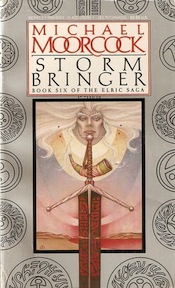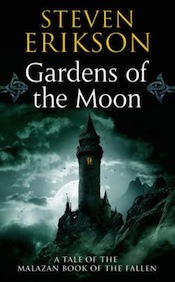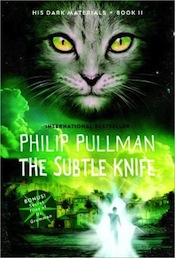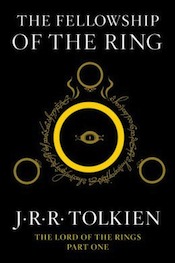Everyone loves a magical weapon. They’ve been a staple of fantasy books for as long as I’ve been reading them, starting with that moment in the Belgariad when Garion places the Orb on the pommel of Iron-Grip’s Sword and is revealed to be the true King of Riva. A hero facing a Dark Lord would no more go into battle without a magical weapon than he would do without a prophecy predicting his victory.
The problem is, the good guys don’t have a monopoly on powerful artefacts. And it’s not just the bad guys who carry weapons with a dubious history. So what happens when you find that the mystical blade is being wielded by someone on the other side to you? It’s about that time, I imagine, that the charm of the weapon begins to wear off a little.
Here are five weapons you really don’t want to see your opponent bring to a fight.
Stormbringer
Stormbringer–Michael Moorcock
 Stormbringer is the weapon of one of the most legendary figures in sword-and-sorcery fantasy, Elric of Melniboné. Strictly speaking, Stormbringer is not a sword, but rather a demon that takes the form of a sword. The first warning you’ll get that something is wrong is when the blade starts singing as it cuts down your companions. It can shear through almost any material. More disturbingly, it takes not just the lives of its victims, but also their souls. And when losing your life isn’t the worst thing that can happen in a fight, that’s probably a fight you should look to sit out.
Stormbringer is the weapon of one of the most legendary figures in sword-and-sorcery fantasy, Elric of Melniboné. Strictly speaking, Stormbringer is not a sword, but rather a demon that takes the form of a sword. The first warning you’ll get that something is wrong is when the blade starts singing as it cuts down your companions. It can shear through almost any material. More disturbingly, it takes not just the lives of its victims, but also their souls. And when losing your life isn’t the worst thing that can happen in a fight, that’s probably a fight you should look to sit out.
Of course, using Stormbringer comes at a terrible cost to the wielder–as Elric himself finds out. I’m guessing that will come as scant consolation, though, to those who have already fallen to his blade.
Dragnipur
Gardens of the Moon–Steven Erikson
 Erikson sees Moorcock’s Stormbringer and raises him with Dragnipur, the sword of Anomander Rake. Dragnipur also steals the souls of its victims, but then traps them inside a magical realm within the blade. They are chained to a cart that contains the Gate of Darkness, and forced to pull it for eternity away from the pursuing forces of Chaos. Some of the beings trapped inside the sword have been there for tens of thousands of years, among them an Elder God called Draconus. But then perhaps that is an apt punishment for Draconus, considering it was he who forged the sword in the first place.
Erikson sees Moorcock’s Stormbringer and raises him with Dragnipur, the sword of Anomander Rake. Dragnipur also steals the souls of its victims, but then traps them inside a magical realm within the blade. They are chained to a cart that contains the Gate of Darkness, and forced to pull it for eternity away from the pursuing forces of Chaos. Some of the beings trapped inside the sword have been there for tens of thousands of years, among them an Elder God called Draconus. But then perhaps that is an apt punishment for Draconus, considering it was he who forged the sword in the first place.
There’s a great scene in Gardens of the Moon when, in the middle of a festival, Anomander Rake has to clear the street in front of him of revellers. His solution? He draws Dragnipur. “The sword groaned awake, chains of smoke writhing from the blade. A terrible sound of wheels creaking filled the air and behind it arose a chorus of moaning …” Yes, that would do it.
The Subtle Knife
The Subtle Knife–Philip Pulman
 The Subtle Knife from Pulman’s His Dark Materials series is also known as Æsahættr (pronounced AS-hatter), which literally means “God-Destroyer.” That’s not a name to inspire confidence in someone facing it in a fight. The knife has a double edge. One edge is so sharp it can cut through any physical material. The other edge is sharper still, narrowing to a point so fine the eye cannot see it. In fact it’s so sharp it can cut through the fabric of the universe and create windows into other worlds. Good luck trying to parry that.
The Subtle Knife from Pulman’s His Dark Materials series is also known as Æsahættr (pronounced AS-hatter), which literally means “God-Destroyer.” That’s not a name to inspire confidence in someone facing it in a fight. The knife has a double edge. One edge is so sharp it can cut through any physical material. The other edge is sharper still, narrowing to a point so fine the eye cannot see it. In fact it’s so sharp it can cut through the fabric of the universe and create windows into other worlds. Good luck trying to parry that.
In the third book of Pulman’s trilogy, The Amber Spyglass, the bearer of the knife, Will, challenges the bear king, Iorek Byrnison, to a duel before demonstrating the power of the dagger by cutting up Iorek’s helmet. The bear king backs down promptly–and wisely.
Morgul-knife
The Fellowship of the Ring–JRR Tolkien
 Morgul-knives are daggers used by Ringwraiths in Middle-earth. Most famously, the Witch-king of Angmar uses one to stab Frodo at Weathertop. After it cuts its victim, the knife leaves behind a splinter of the blade in the flesh. The rest of the blade disintegrates, while the splinter burrows its way into the body. If it isn’t removed quickly enough, the victim becomes a wraith.
Morgul-knives are daggers used by Ringwraiths in Middle-earth. Most famously, the Witch-king of Angmar uses one to stab Frodo at Weathertop. After it cuts its victim, the knife leaves behind a splinter of the blade in the flesh. The rest of the blade disintegrates, while the splinter burrows its way into the body. If it isn’t removed quickly enough, the victim becomes a wraith.
Only the most powerful healers are able to treat a wound inflicted by a Morgul-knife. In The Fellowship of the Ring, Elrond, Lord of Rivendell, is able to remove Frodo’s splinter, but there won’t always be an immortal elven lord standing by to tend to your injuries after a fight. And even after Frodo is healed, the wound from the Morgul-knife continues to pain him from time to time until his departure to the Undying Lands.
Snaga
Druss the Legend–David Gemmell
 Druss is one of my favourite fantasy characters. Armed with his two-handed battleaxe, Snaga, he is all but unbeatable in a fight. In Druss the Legend, Earl Delnar explains why: “That terrible axe rarely leaves a man with a non-mortal wound. To kill Druss you have to be prepared to die. No, not just prepared. You would have to attack Druss in the sure knowledge that he will kill you. Now, most men want to live.” You don’t say.
Druss is one of my favourite fantasy characters. Armed with his two-handed battleaxe, Snaga, he is all but unbeatable in a fight. In Druss the Legend, Earl Delnar explains why: “That terrible axe rarely leaves a man with a non-mortal wound. To kill Druss you have to be prepared to die. No, not just prepared. You would have to attack Druss in the sure knowledge that he will kill you. Now, most men want to live.” You don’t say.
And Snaga is no ordinary battleaxe. A demon inhabits its blades. It can repel magic. It also corrupts its wielder, turning him into a bloodthirsty butcher, rather than the shy and retiring type you’d prefer to be facing. And even when the person carrying the axe isn’t trying to slaughter you, the demon inside might be. At one point in Druss the Legend, Snaga “slips” from Druss’s grip and tries to kill a priest it takes offence to. Only Druss’s sharp reactions save the priest from death.
Honourable mentions: The Possible Sword from China Mièville’s The Scar; Soulcutter from Fred Sabrehagen’s The Book of Swords; and Callandor, the Sword That Is Not A Sword, from Robert Jordan’s Wheel of Time series.
As I was finishing this article, it occurred to me that none of the weapons mentioned above appear in books written by women. I went back to my notes. I’d done some research online to ensure I wasn’t missing any important weapons – and I found that even my shortlist didn’t feature any books by women. So I started thinking back on my favourite fantasy series by women. The Earthsea Quartet by Ursula Le Guin? No magical weapons there that might make the list. The Farseer Trilogy by Robin Hobb? Another no. For fans of Dragonlance, Margaret Weis (and Tracy Hickman) introduced us to a real menagerie of magical weapons. But the likes of a dragonlance wouldn’t trouble you overly in a fight, unless you happened to be a dragon. And I’m assuming you’re not.
So this is where you enlighten me. Which magical weapons featuring in books written by women deserve to be in a top five?
Marc Turner was born in Toronto, Canada, but grew up in England. He graduated from Lincoln College, Oxford University, in 1996 with a BA (Hons) in Law, and subsequently worked at a top-ten law firm in London. After more than ten years in the legal profession he gave in to his lifelong writing addiction and now works full time as a writer. When the Heavens Fall is his first novel–available May 19th from Tor Books!









